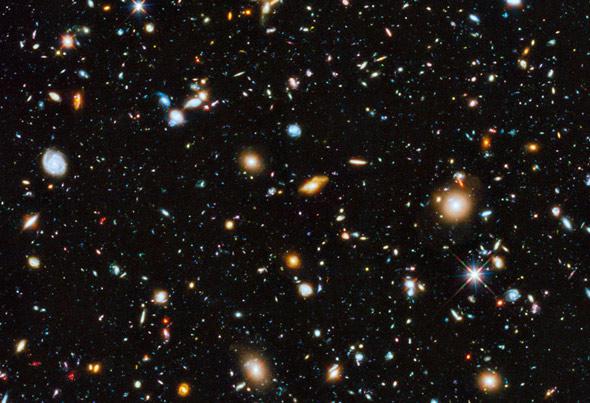One of the biggest leaps in astronomy made by the Hubble Space Telescope was something dreamed up long after it launched: Taking extremely long exposure images of a part of the sky unobscured by foreground junk (like stars, gas, and dust in our own galaxy) to see what could be seen. These images were called the Hubble Deep Fields, because they could see extraordinarily faint galaxies deep in the Universe.
Since the first one was taken in 1995, there have been many others. Some looked at different areas of the sky, some combined the data from other telescopes, and some looked in different wavelengths of light. That last part is important: When massive stars are born, they emit ultraviolet light, but due to the expansion of the Universe, that gets shifted to the red by the time the light gets here. Looking in the infrared lets us see those stars forming more than 10 billion light years away.
But what about the intermediate Universe? Galaxies 5–10 billion light years away pour out a lot of UV light that gets here redshifted, but still in the ultraviolet. We could really use a UV Deep Field.
And now we’ve got one! Behold:

All photos by NASA, ESA, H. Teplitz and M. Rafelski (IPAC/Caltech), A. Koekemoer (STScI), R. Windhorst (Arizona State University), and Z. Levay (STScI)
(Click to embiggen; I only used part of this amazing image here.)
That spectacular picture is a combination of images taken by two Hubble cameras that can detect light from the UV to the IR; in fact, it combines images taken in 11 filters to provide a wide-spectrum look at the intermediate Universe. What’s displayed as blue is actually UV light, green is visible light (the kind we see), and red is IR. So what you see as blue is actually bluer than blue, and what’s red is redder than red.
So to speak.
It’s an astonishing panoply of galaxies. There are 10,000 such beasts in this image, a feast for astronomers who want to understand how the Universe evolves. Remember, it takes light billions of years to reach Earth from these galaxies, so we’re seeing them when the Universe was substantially younger. This helps fill in the gap in our knowledge of this cosmic era.
A small clump of galaxies showing distorted shapes typical of collisions.
As usual in these images, the galaxies show every possible shape and size. Many are distorted, victims of collisions with other galaxies, their mutual gravity pulling them into weird shapes like taffy quadrillions of kilometers across. Many are very blue, showing active star formation, while others are exceedingly red, probably galaxies much farther away, their light taking far longer to reach us. Note that most of the very red galaxies are smaller dots, another indication of their tremendous distance.
There are some stars in the image as well, and they look, well, garish. That’s due to an optical effect together with the way they were observed. Hubble has a big mirror 2.4 meters across that gathers the light from the sky. This is reflected onto a secondary mirror, which in turn reflects the light into the cameras so the images can be recorded.
A star showing colorful diffraction spikes.
That secondary mirror is held inside the telescope by very thin metal strips. Light has a peculiar property that when it encounters a thin obstacle it can bend around it, something like the way waves in water in a flowing creek will bend around an obstacle. This is called diffraction, and is what creates those “diffraction spikes” around stars.
Different colors of light bend by different amounts. That means the spikes appear different when viewed through different colored filters, brighter at different points along the spikes. When all the color images are combined, you get that weird Christmas light look to the stars. Strange, but also quite pretty.
This works best for bright point sources of light; galaxies are dimmer and spread out, washing away the effect—though note in the image above two galaxies with spikes; those must have very bright nuclei, probably with black holes gobbling down matter. These can make them extremely luminous, what we call “active galaxies.” They’re relatively rare, and I only spotted a few in this image.
That makes stars pretty easy to spot in an image like this, and astonishingly, I only see about a dozen or so. Some of the fainter blips might be stars, too, but too faint to create spikes. Either way, it’s clear that the overwhelming majority of objects you see here are galaxies; collections of billions or even hundreds of billions of stars, spread across the Universe.
Images like this will keep astronomers busy for years. Decades. The knowledge they will glean from this will be incredible.
And yet, as I have before, I have to wonder … As important as images like this are to astronomy, I think the long-term impact might be more important on the public. To look upon such beauty and to see how vast our Universe is, how deep it is, how complex, and how spectacular, and yet to know that we can see it, we can study it, and, through science, we can understand it … that may yet prove to be the most profound influence Hubble will have on history.